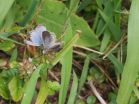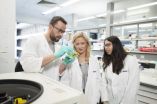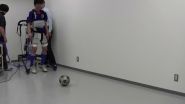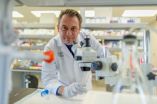Study of Chilean quake shows potential for future earthquake
2014-08-14
(Press-News.org) Near real-time analysis of the April 1 earthquake in Iquique, Chile, showed that the 8.2 event occurred in a gap on the fault unruptured since 1877 and that the April event was not what the scientists had expected, according to an international team of geologists.
"We assumed that the area of the 1877 earthquake would eventually rupture, but all indications are that this 8.2 event was not the 8.8 event we were looking for," said Kevin P. Furlong, professor of geophysics, Penn State. "We looked at it to see if this was the big one."
But according to the researchers, it was not. Seismologists expect that areas of faults will react the same way over and over. However, the April earthquake was about nine times less energetic than the one in 1877 and was incapable of releasing all the stress on the fault, leaving open the possibility of another earthquake.
The Iquique earthquake took place on the northern portion of the subduction zone formed when the Nazca tectonic plate slides under the South American plate. This is one of the longest uninterrupted plate boundaries on the planet and the site of many earthquakes and volcanos. The 8.2 earthquake was foreshadowed by a systematic sequence of foreshocks recorded at 6.0, 6.5, 6.7 and 6.2 with each foreshock triggering the next until the main earthquake occurred.
These earthquakes relieved the stresses on some parts of the fault. Then the 8.2 earthquake relieved more stress, followed by a series of aftershocks in the range of 7.7. While the aftershocks did fill in some of the gaps left by the 8.2 earthquake, the large earthquake and aftershocks could not fill in the entire gap where the fault had not ruptured in a very long time. That area is unruptured and still under stress.
The foreshocks eased some of the built up stress on 60 to 100 miles of fault, and the main shock released stress on about 155 miles, but about 155 miles of fault remain unchanged, the researchers report today (Aug. 13) in Nature.
"There can still be a big earthquake there," said Furlong. "It didn't release the total hazard, but it told us something about this large earthquake area. That an 8.8 rupture doesn't always happen."
The researchers were able to do this analysis in near real time because of the availability of large computing power and previously laid groundwork.
The computing power allowed researchers to model the fault more accurately. In the past, subduction zones were modeled as if they were on a plane, but the plate that is subducting curves underneath the other plate creating a 3-dimensional fault line. The researchers used a model that accounted for this curving and so more accurately recreated the stresses on the real geology at the fault.
"One of the things the U.S. Geological Survey and we have been doing is characterizing the major tectonic settings," said Furlong. "So when an earthquake is imminent, we don't need a lot of time for the background."
In essence, they are creating a library of information about earthquake faults and have completed the first level, a general set of information on areas such as Japan, South America and the Caribbean. Now they are creating the levels of north and south Japan or Chile, Peru and Ecuador.
Knowing where the old earthquake occurred, how large it was and how long ago it happened, the researchers could look at the foreshocks, see how much stress they relieved and anticipate, at least in a small way, what would happen.
"This is what we need to do in the future in near real time for decision makers," said Furlong.
INFORMATION:
Other researchers working on this project were Gavin P. Hayes, former Penn State Ph.D. student now at U.S.G.S.; Matthew W. Herman, graduate student in geoscience, Penn State; William D. Barnhart, Harley M. Benz and Paul S. Earle, U.S.G.S; Sebástian Riquelme and Sergio Barrientos, Centro Sismológico Nacional, Universidad de Chile; Eric Bergman, Global Seismological Services; and Sergey Samsonov, Canada Centre for Mapping and Earth Observations, Natural Resources Canada.
The National Science Foundation and the U.S.G.S. supported this research.
ELSE PRESS RELEASES FROM THIS DATE:
People fake to look authentic on social media
2014-08-14
Presenting an authentic image on social network sites (SNSs) includes an element of fakery according to a new study by researchers at Aalto University. During the study, researchers discovered that being authentic is very important for social media users. At the same time, users also admitted faking parts of their online image in order to conform to social norms and expectations.
By focusing on two SNSs, Facebook and Last.fm, the researchers came to the conclusion that being real is much more acceptable according to social norms.
Although both of these SNSs differ ...
Fukushima's legacy
2014-08-14
Following the 1986 Chernobyl nuclear power plant meltdown, biological samples were obtained only after extensive delays, limiting the information that could be gained about the impacts of that historic disaster. Determined not to repeat the shortcomings of the Chernobyl studies, scientists began gathering biological information only a few months after the disastrous meltdown of the Fukushima Daiichi power plant in Japan in 2011. Results of these studies are now beginning to reveal serious biological effects of the Fukushima radiation on non-human organisms ranging from ...
Immune cell discovery could help to halt cancer spread
2014-08-14
Melbourne researchers have revealed the critical importance of highly specialised immune cells, called natural killer cells, in killing melanoma cells that have spread to the lungs.
These natural killer cells could be harnessed to hunt down and kill cancers that have spread in the body.
The team, from the Walter and Eliza Hall Institute, also found natural killer cells were critical to the body's rejection of donor bone marrow transplants and in the runaway immune response during toxic shock syndrome.
The discoveries came after the team showed that a protein called ...
Newborns' genetic code sends infection distress signal
2014-08-14
Babies suffering from life-threatening bacterial infections such as sepsis could benefit from improved treatment, thanks to a ground-breaking study.
For the first time, researchers have been able to detect and decode a signal generated from a baby's DNA that can tell doctors whether or not a bacterial infection is present in the bloodstream.
The findings could help develop a test for bacterial infection in newborns, using a single drop of blood.
Immediate detection of such infections, which are a major cause of death among young children, is currently impossible ...
Bypass commands from the brain to legs through a computer
2014-08-14
VIDEO:
The right arm muscles and the locomotion center of the man are artificially connected through a computer. His legs are in a relaxed state. When he moves his right hand,...
Click here for more information.
Gait disturbance in individuals with spinal cord injury is attributed to the interruption of neural pathways from brain to the spinal locomotor center, whereas neural circuits locate below and above the lesion maintain most of their functions. An artificial connection ...
Aspirin may slow recurrence in breast cancer patients
2014-08-14
SAN ANTONIO (August 14, 2014) — New findings published today in the journal Cancer Research reveal that some postmenopausal overweight breast cancer patients who use common anti-inflammatory drugs like aspirin or ibuprofen have significantly lower breast cancer recurrence rates.
Researchers from the Cancer Therapy & Research Center at The University of Texas Health Science Center at San Antonio and the University of Texas at Austin began by examining blood serum from CTRC breast cancer patients, said CTRC oncologist Andrew Brenner, M.D., Ph.D.
Studying Blood Serum
They ...
Protein found to block benefits of vitamin A cancer therapy
2014-08-14
Retinoic acid is a form of vitamin A that is used to treat and help prevent the recurrence of a variety of cancers, but for some patients the drug is not effective. The reason for this resistance was unclear until this week when researchers from Virginia Commonwealth University (VCU) Massey Cancer Center demonstrated that a protein known as AEG-1 blocks the effects of retinoic acid in leukemia and liver cancer. Because AEG-1 is overexpressed in nearly every cancer, these findings could impact the care of countless cancer patients.
Details of the study were published ...
Lionfish characteristics make them more 'terminator' than predator
2014-08-14
SACRAMENTO, Calif. – New research on the predatory nature of red lionfish, the invasive Pacific Ocean species that is decimating native fish populations in parts of the Caribbean Sea and Atlantic Ocean, seems to indicate that lionfish are not just a predator, but more like the "terminator" of movie fame.
The finding of behavior that was called "alarming" was presented today by Kurt Ingeman, a researcher from Oregon State University, at the annual meeting of the Ecological Society of America.
Most native predatory fish are attracted to prey when their numbers are high, ...
NSAIDs may lower breast cancer recurrence rate in overweight and obese women
2014-08-14
PHILADELPHIA — Recurrence of hormone-related breast cancer was cut by half in overweight and obese women who regularly used aspirin or other nonsteroidal anti-inflammatory drugs (NSAIDs), according to data published in Cancer Research, a journal of the American Association for Cancer Research.
"Our studies suggest that limiting inflammatory signaling may be an effective, less toxic approach to altering the cancer-promoting effects of obesity and improving patient response to hormone therapy," said Linda A. deGraffenried, PhD, associate professor of nutritional sciences ...
Mayo Clinic challenges some recommendations in updated cholesterol treatment guideline
2014-08-14
A Mayo Clinic task force challenges some recommendations in the updated guideline for cholesterol treatment unveiled by the American College of Cardiology (ACC) and American Heart Association (AHA) in 2013. The task force concludes, based on current evidence, that not all patients encouraged to take cholesterol-lowering medications, such as statins, may benefit from them and that the guideline missed some important conditions that might benefit from medication.
Furthermore, the task force believes an emphasis needs to be placed on an individualized treatment approach ...





